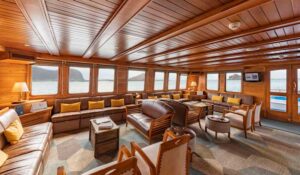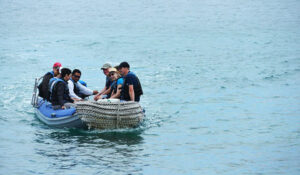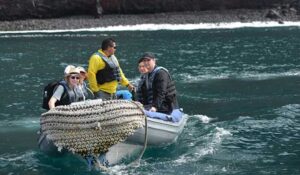
Frequently Asked Questions about Galapagos Islands
Do I need travel insurance?
Travel insurance, including medical evacuation cover, is mandatory for all voyages. We advise you have insurance for voyage cancellation to ensure you will be covered financially if you are forced to cancel your voyage due to circumstances beyond your control.

Will I get seasick?
Many people ask us if they will get seasick. It is a very difficult question to answer, as it depends so much on the individual. Our experience is that a small percentage of people are seasick on any trip and most of these people are fine after a day or so at sea. If you feel that you are particularly susceptible to seasickness, then it is a good idea to talk to your doctor. We advise you come armed with motion sickness tablets, and there will be a doctor on board to assist with any bouts of seasickness.

Is there Internet, email or telephone access on board?
On-board WiFi internet packages are usually available for purchase during the voyage. Telephone access for personal use is not available on board. In case of an emergency, all ships will have satellite phones.

How many people can go ashore at one time?
The Galapagos Islands National Park regulates the number of guests and the number of boats visiting each island every day.
A Galapagos National Park Accredited Guide can escort a maximum of 16 guests ashore. Larger ships with up to 100 guests will have six or seven Naturalist Guides each escorting 16 guests ashore in small groups.

How does the Galapagos Islands National Park regulate where ships go every day?
All ships are required to submit their itineraries in advance and the National Park Directorate ensures that boats are evenly spread across all Islands and sites. Consequently, each ship has a fixed itineraries.
It is possible to have three or four smaller (16 guest) ships all at the one site or island at the same time. However, if there is a large ship with, for example, 50-100 guests, it will likely be the only ship at that site at that time.

What are the benefits of the different size ships?
Larger ships can be a little more stable and have a range of guides, potentially offering a greater range of activities at the one site and time.
On the other hand, smaller ships have fewer guests to go ashore, thus everyone can get ashore more quickly. Additionally, smaller ships can offer a more intimate and personal experience.

What is the best time to visit?
The Galapagos Islands are pleasant to visit year-round. Despite their sub-tropical location on the equator, the cold waters of the Humboldt Current which surrounds the islands keeps the temperatures pleasant.
The Galapagos has two main seasons:
- December to June: warm, becoming hot and humid from January to March
- July to November: cooler, more wind, mainly dry, with some misty drizzle

When is the water at its warmest?
From December to May (unless affected by an El Nino event).

Do I need a visa?
No visa is currently required to enter Ecuador (for Australian passport holders). A Galapagos Transit Control Card (of USD $20) and a Galapagos National Park Fee (of USD $100) are required.

What is the food like?
Generally, food onboard the ships is of a very high standard. Luxury boats have a greater emphasis on proving excellent cuisine.

What activities are included?
Ships offer escorted excursions in Pangas (small inflatable zodiacs) and on foot, ashore. Snorkeling equipment is provided for use at appropriate sites. Some ships also offer kayaking.

Can you walk around the islands?
Yes, exploring the islands on foot is one of the main activities. You are required to stay with your guide and keep to the trails. The wildlife is often unafraid, making it possible to get close to many species.

Is it safe to snorkel and how much experience do I need?
Most ships offer snorkeling. This activity has become more popular and allows a unique view into the marine life found in the Galapagos. It is important to be able to swim proficiently to avoid distress in the water, however, little to no snorkeling experience is required. White tipped reef sharks, marine iguanas, green sea turtles (and more!) are often seen.
Please note that diving is not offered on most boats. Specialist dive boats cater to more serious divers.

Do you see wild Galapagos Tortoises?
Most itineraries will include a visit to one of the multiple Tortoise Breeding Centres on the islands. Other itineraries may offer vehicle-based trips into the highlands to visit farms upon which Giant Tortoises roam freely.

Will I see volcanic eruptions in the Galapagos?
The Galapagos Islands are one of the world’s ‘hot spots’. The Galapagos Archipelago is one of the most volcanically active areas in the world. Situated atop a hotspot in the western Pacific, the islands were created over millennia of volcanic activity. As magma repeatedly broke through the sea floor, it formed layer upon layer of rock, eventually becoming islands.
It is not unusual for one of the ‘newer’ islands to have flows of magma.

What is Darwin's Theory of Evolution, and why is the Galapagos important to the theory?
Charles Darwin spent many months in the Galapagos Islands aboard the Endeavour in 1835.
He noticed that across the different islands, many of the animals displayed differences to mainland species. As a result, he theorised that isolation (over thousands of years) causes animals to adapt to suit the demands of their specific environments.
The Galapagos finches particularly gained his attention. On different islands, these finches displayed different beaks; some large, some small, some sharp, some rounded. Each beak was specifically suited to the availability of the particular foods on each island. Eventually, Darwin theorised that the finches had evolved into distinct species on different islands; their differing beaks being an adaptation to unique natural habitats and environmental niches. It is believed there are 13 different species of the Galapagos finch.


